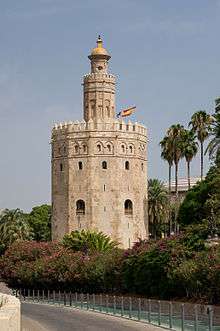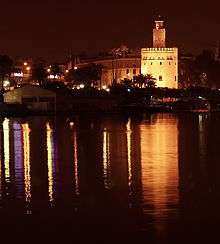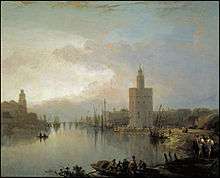Torre del Oro

The Torre del Oro (English: "Tower of Gold") is a dodecagonal military watchtower in Seville, southern Spain. It was erected by the Almohad Caliphate in order to control access to Seville via the Guadalquivir river.
Constructed in the first third of the 13th century, the tower served as a prison during the Middle Ages. Its name comes from the golden shine it projected on the river, due to its building materials (a mixture of mortar, lime and pressed hay).
The tower is divided into three levels, with the third and uppermost being circular in shape and added in 1769. The Torre de la Plata, an octagonal tower, is located nearby, and is believed to have been constructed during the same era.
Military function
It is one of two anchor points for a large chain that would have been able to block the river. The other anchor-point has since been demolished or disappeared, possibly from collapsing during the 1755 Lisbon earthquake. The chain was used in the city's defense against the Castilian fleet under Ramón de Bonifaz in 1248 Reconquista. Bonifaz broke the river defenses and isolated Seville from Triana. The besieged Muslim city soon surrendered to the Christian forces.
Historical role


The Tower of Gold was built 1220-1221, by order of the Almohad governor of Seville, Abu l-Ulà, with a twelve-sided base. It barred the way to the Arenal district with a section of wall joining it to the Tower of Silver, a part of the city walls that defended the Alcazar.
There is a false tradition that a heavy chain went across the river from this tower to another located on the modern-day Fortaleza (Fortress) Street in Triana. That street was called Limones (Limes) Street until the nineteenth century, and also, the Chronicles written by King Alfonso X the Wise describe in detail the taking of the city of Seville. They mention the Torre del Oro by name, and only a chain that held a set of boats bridging Seville with what is now the Castle of St. George, on the Triana side. The Castilian fleet commanded by Admiral Ramon de Bonifaz broke through that chain and bridge of boats in 1248 to go up the river, while the troops of Ferdinand III of Castile besieged the city. This historic passage led by Asturian and Cantabrian sailors in the service of the Castilian navy has been immortalized on the shields of Aviles and of the Four Villas of the Coast of Cantabria (Laredo, Castro Urdiales, Santander, and San Vicente de la Barquera). It was later incorporated in the Coat of Arms of Cantabria as well, represented by the Tower of Gold and a ship breaking chains that closed passage up the Guadalquivir River. After this re-conquest, the tower was first used as a chapel dedicated to St. Isidore of Seville, and later it became a prison.
The name Torre del Oro clearly comes from the gleam of lime mortar and straw that the building displayed. The legend that the tower was a storehouse for the gold and silver brought from America is completely false. Also false is the sixteenth century claim of chronicler Luis Peraza that the tower was covered with tiles that sparkled in the light of the sun. This same chronicler and Lopez de Ayala say that King Pedro I kept treasures of gold and silver in the tower, which is true. Gold was processed at the Mint, several yards away, and Pedro I kept not only coins in the tower, but also the sister of Maria Coronel, the lady Aldonza Coronel. The king had fallen in love with Aldonza and took her out of the Convent of Santa Clara in 1357. As she asked Pedro I for forgiveness for her husband, Alvar Perez de Guzman, she agreed to leave the monastery. However, once Maria Padilla entered the Royal Alcazar as the king's new favorite, Pedro I put Aldonza in the tower under guard.
The tower was badly damaged by the Lisbon earthquake of 1755, and the Marquis of Monte Real proposed demolishing it to widen the way for horse-drawn coaches and straighten access to the bridge of Triana; however, the people of Seville objected and appealed to the king, who intervened. In 1760, the damage was repaired, with repairs to the bottom floor of the tower, reinforcement with rubble and mortar, and making the passageway to the path around the wall the door of main access. That same year, the upper cylindrical body was built, a work of the military engineer Sebastian Van der Borcht, also architect of the Royal Tobacco Factory of Seville. These works changed the appearance of the tower as compared to what is seen in engravings from the sixteenth or seventeenth centuries.
The Revolution of 1868 brought another crisis to the tower, because revolutionaries demolished the artistic surfaces of the walls and put them up for sale. Opposition from the citizens of Seville kept the tower from being destroyed, and in 1900 it was again restored, this time by engineer Carlos Halcon. On April 10, 1923, King Alfonso XIII visited the tower, and on March 21, 1936 the Maritime Museum was installed in the Tower by order of the Admiralty. In September 1942, more restoration work began. The appearance of the facade was improved, two floors were set up for museum display, and the third floor was prepared to house researchers. The museum held its grand opening on July 24, 1944, for which occasion 400 museum pieces were brought from the Naval Museum of Madrid.
On August 13, 1992, the Torre del Oro was made a brother to the Tower of Belem of Lisbon to celebrate the Universal Exposition in Seville. As of 2008 the museum displayed a variety of old navigational instruments and models, as well as historical documents, engravings, and nautical charts, relating Seville to the Guadalquivir River and the sea. The tower was again restored in 2005.
External links
| Wikimedia Commons has media related to Torre del Oro. |
Coordinates: 37°22′56.79″N 5°59′47.28″W / 37.3824417°N 5.9964667°W